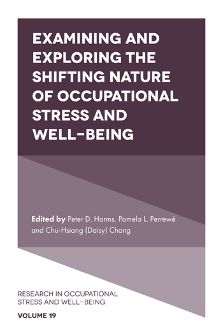
Index
Examining and Exploring the Shifting Nature of Occupational Stress and Well-Being
ISBN: 978-1-80117-423-7, eISBN: 978-1-80117-422-0
ISSN: 1479-3555
Publication date: 6 September 2021
Citation
(2021), "Index", Harms, P.D., Perrewé, P.L. and Chang, C.-H.(D). (Ed.) Examining and Exploring the Shifting Nature of Occupational Stress and Well-Being (Research in Occupational Stress and Well Being, Vol. 19), Emerald Publishing Limited, Leeds, pp. 201-206. https://doi.org/10.1108/S1479-355520210000019010
Publisher
:Emerald Publishing Limited
Copyright © 2021 Peter D. Harms, Pamela L. Perrewé and Chu-Hsiang (Daisy) Chang
INDEX
Index
- Prelims
- The Purpose and Work Stress Model: Contextualizing the Role of Purpose on and Following Stressful Work Experiences
- Adaptive and Proactive Coping in the Process of Developing Resilience
- The Role of Crucibles as Developmental Experiences in Organizations
- The Role of Velocity in Occupational Stress Across the Career Span
- Shifting Nature of Occupational Well-being: Examining Inconsistent Findings from Generational Research Using a Lifespan Perspective
- Handling Time in Occupational Stress and Well-Being Research: Considerations, Examples, and Recommendations
- Experience Sampling Methodology: Conceptual and Technological Advances for Understanding and Assessing Variability in Well-being Research
- Modeling Occupational Stress and Well-Being as a Dynamic Phenomenon: It’s About Time
- Examining the Dynamic Nature of Worker Subjective Well-being: The Application of Idiographic Approaches
- Index